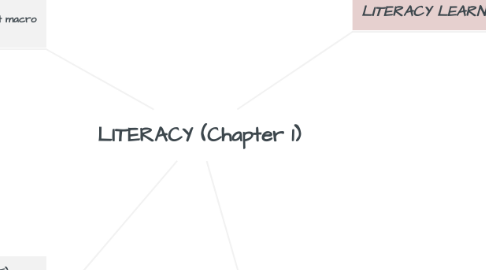
1. There are many different definitions of Literacy. Definitions and theoretical perspective influence curricular decision-making (both at macro and micro levels).
1.1. EYLF (P. 2)
1.2. Australian Curriculum (pp 2,3) [Language and literacy change according to context]
1.2.1. LANGUAGE: "knowing about English"
1.2.2. LITERATURE: "understanding, appreciating, responding to, analysing and creating literary texts"
1.2.3. LITERACY: "expanding the repertoire of English usage"
1.3. Educators develop their own definition throughout their careers. (Influenced by experiences, reading, discussions, beliefs etc.).
1.4. Espoused theory (what we say or think we believe about literacy) vs Theory in use (theory underpinning our actual practices) (textbook p. 4)
2. MULTILITERACIES (p. 5) [Term coined by New London Group (NLG) in 1996
2.1. Many literacies stem from the communicative practices of diverse cultures. The role of technology in literacy is also foregrounded.(+ scientific literacy vs visual literacy vs critical literacy etc)
2.2. MULTILITERACIES MAP, South Australia (pp. 4-5)
2.3. Why is multiliteracties pedagogy important? It aligns with contemporary early childhood policies which acknowledge and values diversity and children's voices (p. 5)
3. THEORETICAL PERSPECTIVE ON LITERACY LEARNING
3.1. MATURATIONAL
3.1.1. Children can only learn to read or write when they reach biological maturity (p. 6) - Gesell
3.1.1.1. Perspective originated from Gesell's work. Mainly psychologists. Only considered observable and measurable aspects through chemistry and biology. Mature age was considered to be 6 years old. A readiness test was used.
3.2. COGNITIVE DEVELOPMENTAL
3.2.1. Environmental and classroom-based experiences and activities can speed up the maturation process (although children still need to reach a point of 'readiness') (p. 6). - Thorndike (psychologist)
3.3. EMERGENT (1970s)
3.3.1. Early experiences in the home and community we central to literacy learning (p.7) - Piaget
3.3.1.1. Children's literacy learning process is active, constructive and social. Scribbling, storybook, talking singing etc very important for children.
3.3.1.2. WHOLE LANGUAGE (Marie Claire, Ken Goodman, Frank Smith)
3.3.1.2.1. = philosophy of literacy education = encourages educators to teach reading and writing starting with whole texts, rather than words and letters in isolation
3.3.1.3. CAMBOURNE'S SEVEN CONDITIONS (p. 7)
3.3.1.3.1. Children learn written language the same way the learn spoken/oral language. Therefore children have to be exposed and immerse in it to grasp it.
3.3.1.3.2. Immersion
3.3.1.3.3. Demonstration
3.3.1.3.4. Expectation
3.3.1.3.5. Responsibility
3.3.1.3.6. Approximation
3.3.1.3.7. Employment
3.3.1.3.8. Feedback
3.4. SOCIO-CULTURAL (1990s)
3.4.1. Literacy is seeing as a social practice. Varies according to communicative purpose and socio-cultural context (p. 8) - Vygotsky
3.4.1.1. Children's cultural capital and funds of knowledge may be advantageous to children learning or may not be appropriate to formal education contexts. Educators need to find way to build bridges between home and school literacies.
3.4.1.2. Barrat-Pough's six elements of a socio-cultural view of literacy (p.8)
3.4.1.3. FREEBODY AND LUKE'S SOCIO-CULTURAL PERSPECTIVE (p. 8-9)
3.4.1.3.1. Four sets of roles, resources or practice that children need to be able to control to become effective readers and writers. Elements are not hierarchical but equally important.
3.4.1.3.2. Code breaker: letter sound correspondences+ grammar
3.4.1.3.3. Text participant: making meaning of the. text
3.4.1.3.4. Text user: understanding there are different types of texts for different purposes
3.4.1.3.5. Text analyst: appreciating that texts are not neutral and that authors have values and agendas that readers nee to uncover and think about (critical literacy)
3.5. EVIDENCE-BASED APPROACHES
3.5.1. Emphasises role of research: educators need to know what research literature says about "what works" rather than just rely on traditional methods
3.5.1.1. Educators need to keep up to date with new research findings and constantly reflect on their practices in the light of these.
3.5.1.2. VISIBLE LEARNING
3.5.1.2.1. a well-known synthesis of meta-analyses that offers 'effect sizes' for a wide range of teaching strategies and approaches. Effect size= differences between groups or indicate progress (p. 9).
3.5.1.3. https://evidenceforlearning.org.au Teaching toolkit summarise different approaches
4. AFFECTIVE FACTORS AND YOUNG CHILDREN'S LITERACY LEARNING
4.1. "Educators need to create environments in which children can experience texts (spoken, written and multimodal) and experiment with them with a sense of purpose, agency and enjoyment" (p. 11).
4.1.1. Intrinsic motivation is what educators should attempt to generate. To do so it is essential to ensure success through the provision of appropriate instructions (scaffold) and literacy activities. Feedback and experiences success help children be more motivated.
4.1.1.1. Elements of literacy motivation
4.2. ASSESSING AFFECTIVE FACTORS (p.11)
4.2.1. Educators have to find out about children's feelings about themselves as readers and writer and about their reading interest. How? Through observing their writing and reading behaviours, conversing with them and/or parents and monitoring their reading logs/journals.
4.2.2. Elementary Reading Attitude Survey (ERAS) is a survey suitable for Year 1 and above. Statements about reading (circling Garfield)
